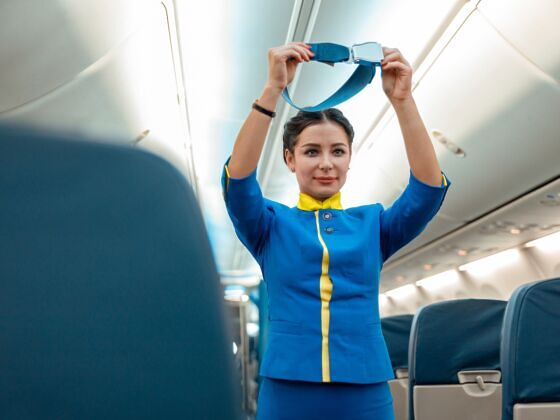It’s easy for frequent flyers to ignore or even scoff at airplane safety demonstrations, sarcastically proffering that if the aircraft was to go down, wearing a seatbelt would not save their lives. Those people are wrong. Wearing a seatbelt is one of the main things you can do to ensure your safety. And much like wearing a seatbelt in a moving car, wearing one throughout a flight is non-negotiable.


Why You Should Absolutely Wear Your Seatbelt When Flying, According to a Pilot and Flight Attendant
Ask Cuong Tran, one of the passengers who was sitting near a gaping hole in the fuselage of an Alaska Airlines Boeing 737 Max 9 on January 5, 2024, after a door panel blew off during take-off. USA Today reports that the violent suction coming from the hole took away his shoes and socks, and hurt his foot. Tran’s seatbelt most likely saved his life.
@strawberr.vy Girls’ trip turned into emergency landing trip… #alaska #alaskaair ♬ original sound – vy 🍓
The unpredictable nature of in-flight incidents, whether they are as serious as a door plug blowing off or as minor as turbulence, means that air travelers should wear their seatbelts at all times when seated, no matter how uncomfortable.
“It is one of the most important things you can do for not only your own safety but the safety of everyone around you,” explains Tyler Herbert, an experienced airline pilot in Canada. “Obviously pilots try to always be aware of any turbulence in the area we are flying, however there is always the chance of finding turbulence that’s unexpected. People could fall and hurt themselves and others if they aren’t secured.”
Nicolas Bessuejouls, who has been working as a flight attendant for the past 16 years, echoes Herbert’s comments. “As I always tell my passengers, wearing a seatbelt is the only thing they need to do to stay safe,” Bessuejouls says. “No matter how strong the turbulence is, if they stay seated and secured they are perfectly safe and prevent hurting themselves or others.” Bessuejouls goes on to say “I always recommend to wear the seatbelt every time [the passengers] are seated, with or without turbulence and even if the seatbelt sign is off.”
But while wearing your seatbelt during a flight is of the utmost importance, you have to wear it properly for it to actually keep you safe. For example, don’t follow the advice of influencers on TikTok who dangerously encourage air travelers to wear their seatbelts around their ankles for more comfort. In case of severe turbulence, wearing your seatbelt around your ankles won’t protect you from falling over your neighbor, hitting the seat in front of you, or prevent you from hitting your head on the cabin ceiling. Instead, follow the recommendations from experts like Christina Ling, the flight attendant instructor behind the TikTok account @flightattinstructor. Ling explains that for maximum protection, passenger should wear their seatbelt tightly on the lower part of their torso (on or above the belly button) to keep their organs safe.
@flightattinstructor 5 things I wouldn’t do as a Flight Att Instructor #5things #5thingsiwouldneverdo #thingsiwishiknew #thingsiwouldneverdo #5thingschallenge #5things #FreestyleFridays #OneDegreeMore #airplane #airplanetiktok #travel #traveltiktok ♬ original sound – flightattinstructor
Any it’s not just passengers who have to wear their seatbelts properly during a flight, pilots and flight attendants must do the same.
“Pilots are always to be wearing their seatbelts any time we are seated,” Herbert says. “Again it’s just an extra layer of protection in the event of turbulence or even something as major as a window shattering. I’m sure you have heard of the incident with British Airways with the captain being partially sucked out the window when one blew out. I believe he was wearing his seatbelt but perhaps not properly. I can’t remember the details exactly. But if something like this were to happen the seatbelt is hopefully going to save us.”
While flight attendants do spend a lot of time on their feet, Bessuejouls explains that they also need to wear their seatbelts at crucial times during a flight. “Everytime we occupy or crew jumpseats for take off and landing, or when informed by the captain in command that a turbulence is approaching. In addition, we always use our judgement and when we feel like weather is getting bad, we always seat and fasten our seatbelts.”
In conclusion, listen to the experts, those are here to insure your safety while in an aircraft, they know better than anyone else.